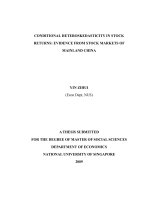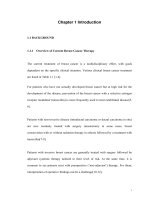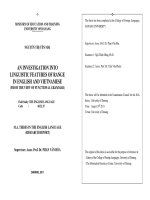In vitro shoot proliferation from nodal segments of Indian blackberry (Syzygium cumini L.)
Bạn đang xem bản rút gọn của tài liệu. Xem và tải ngay bản đầy đủ của tài liệu tại đây (216.09 KB, 6 trang )
Int.J.Curr.Microbiol.App.Sci (2019) 8(3): 2464-2469
International Journal of Current Microbiology and Applied Sciences
ISSN: 2319-7706 Volume 8 Number 03 (2019)
Journal homepage:
Original Research Article
/>
In vitro Shoot Proliferation from Nodal Segments of
Indian Blackberry (Syzygium cumini L.)
Vividha M. Sirsat, Darasing R. Rathod, Santosh J. Gahukar,
Amrapali A. Akhare, Vijay L. Gawande, Neha C. Maske, Balwant S. Munde,
Dipika A. Padole and Aditya V. Rathod
Biotechnology Centre, Dr. Panjabrao Deshmukh Krishi Vidyapeeth,
Akola, Dist. Akola (M.S.), India
*Corresponding author
ABSTRACT
Keywords
in vitro, Indian
blackberry, Jamun,
Micropropagation,
Nodal segment,
Proliferation,
Syzygium cumini L.,
Woody plant media
Article Info
Accepted:
20 February 2019
Available Online:
10 March 2019
Micropropagation of Indian Blackberry (Syzygium cumini L.) species locally called as
Jamun, has always been a challenging task. In India, Jamun tree is an underutilized minor
fruit crop species possessing a high medicinal and nutritional value. An efficient protocol
for rapid shoot proliferation of Jamun (cv. Rajamun) from nodal segment of locally grown
mature trees has been developed. Experiments were conducted at Biotech Centre, Dr.
PDKV, Akola during 2016-18. The Lloyd and McCown woody plant medium (WPM)
used as a basal media supplemented with growth regulators at varying concentrations.
Nodal explants were cultured on WPM supplemented with BAP (6-Benzylamino purine 8,
8.5 and 9 µM/l), Kn (Kn 8, 8.5 and 9 µM/l). WPM supplemented with BAP + Kn @ 8
µM/l was proved to be significantly best at 5% level for high survival rate of 93.33% and
required less time i.e. 32.43 days to initial shoot sprout after explants inoculated with 2.53
initial shoot multiples. The treatments for shoot proliferation were conducted on WPM
supplemented with BAP @ 13, 14 and 15 µM/l, Kn @ 8, 8.5 and 9 µM/l and NAA
(Naphthalene acetic acid) @ 5 µM/l. For high frequency multiple shoot induction WPM
with 13µM BAP + 8.5µM Kn + 5µM NAA was proved to be significantly superior at 5%
level after 4 weeks of first subculture giving 2.87 shoot multiples, followed by maximum
4.20 shoot multiples at 6 weeks stage of second subculture with significantly 3.21cm shoot
length elongation at 10 weeks when supplemented on same media against 1 cm of control.
Introduction
India is a tropical country, where many minor
fruit tree species are very popular and their
fruits are always in high demand as the
seasonal delicacies. However, most of these
fruit trees are not commercially cultivated due
to the poor viability of their seeds and remain
underutilized for their medicinal and
nutritional value. These fruit trees provide a
significant support to the livelihood of rural
and tribal people as they generate additional
household
income.
Indian
Blackberry
(Syzygium cumini L.) locally known as
‘Jamun’ is one of such underutilized minor
fruit species having great importance in India.
The use of medicinal plants plays an important
role in the lives of rural poor peoples,
2464
Int.J.Curr.Microbiol.App.Sci (2019) 8(3): 2464-2469
particularly in remote parts of developing
countries, which are poorly served with health
facilities. Products derived from plants or its
any part that found in the tropical forests is not
only useful for traditional medicine, but also
often has a considerable market value. The
sale of raw materials for pharmaceutical
purposes can be especially important for
subsistence farmers. Plant tissue culture is
widely used and commercially viable
technique of Plant Biotechnology. Tissue
culture is more successful in soft, succulent,
asexual and vegetative propagated plant
species as compare to hard species. Woody
plants are more difficult to propagate than
herbaceous species. The currently followed
methods of propagation of woody species are
cuttings, grafting and layering. But these
methods have been less successful with woody
plants. It is due to the rapid loss of rooting
ability with age of woody plant and the limited
number of propagules that can be obtained in a
reasonable time. The conventional methods of
propagation of woody plants have limited
potential for their large-scale multiplication
and production. Apart from this S. cumini
suffers from very low seed viability and poor
germination in its natural habitat (Dent, 1948).
The seed germinates when fresh but, after two
weeks at room temperature, the same seed is
not viable. Seed storage behaviour is
recalcitrant; germinate well when fresh but its
viability is lost within two weeks of open
storage at room temperature. Due to their
commercial importance and extensive use in
medicine, there is a need to develop rapid and
reliable methods of in-vitro propagation of
woody plant species. It is therefore, a need to
identify tree species which are capable of
multiple uses, such as wood production as
well as alternative products such as medicines.
This would promote recognition of the value
of particular species and result in their
inclusion and consideration in forest
management planning. Such forest trees can
serve as man's medicines and many other
needs while assisting in protecting the
environment upon which animals and other
living creatures depend. Considering its great
medicinal value, large scale cultivation of elite
species of Indian blackberry is underway in
many parts of Maharashtra particularly
Vidarbha regions. The mass scale production
of Jamun seedling of elite and economical
species
under
government
sponsored
entrepreneurship program that could be
possible to generate additional revenue.
Therefore an attempt was made to establish a
standard tissue culture protocol for in vitro
shoot proliferation using nodal segment of
Indian blackberry (Jamun).
Materials and Methods
The experimental work was conducted at Plant
Tissue Culture laboratory, Centre of
Excellence in Plant Biotechnology, Dr.
Panjabrao Deshmukh Krishi Vidyapeeth,
Akola, Dist. Akola (M.S.) during year 201718. The explants (nodal segment) were
collected from the campus in sterilized
polythene bags and were brought in the
laboratory for further processes. The explants
were washed with sterilized water to remove
the extra dust particles. Explants were then
subjected with 1% Tween-20 detergent for
5mins, followed by 1% Bavistin (systemic
fungicide) for 25mins and 1% Streptocycline
antibiotic for 25mins on orbital shaker
followed by repeated washing with sterilized
water thrice after each sterilization treatment.
The explants were further treated with 0.1%
HgCl2 solution under laminar air flow for 5-7
mins followed by washing with distilled
water. To minimize the effect of phenols in
explants, they were treated with antioxidants
solution (0.1% ascorbic acid + 0.05% citric
acid) for 20-25 mins. The experiment was laid
out in Completely Randomized Design with
three replications. This study was carried out
to standardize media combinations for in vitro
culture establishment protocol by using nodal
2465
Int.J.Curr.Microbiol.App.Sci (2019) 8(3): 2464-2469
explant. The protocol showed variable
response of nodal explants on nutrient media
with different growth regulators combinations.
The nodal explants were inoculated on Lloyd
and McCown (woody plant media, 1980)
supplemented with different combinations of
cytokinin’s i.e. Benzyl 6 amine purine, Kn
(Kn) @ 8.0 µM, 8.5 µM and 9.0 µM. Woody
plant media without cytokinin hormone was
treated as control summarized in table 1 and
figure 1. The cultures were maintained in
culture room at temperature of 25 ± 2 ºC with
1000 lux or lower light generated by
fluorescent tubes, automatic timers were used
to regulate photoperiod. The time period was
imposed at an interval of week period viz., 1st,
2nd, 3rd and 4th weeks. The response of
established cultures on woody plant media
with different growth regulators combinations
on shoot proliferation with BAP @13 µM, 14
µM, 15 µM per litre, Kn @ 8.0 µM, 8.5 µM,
9.0 µM per litre and NAA @ 5.0 µM/l were
tested under time interval of week basis. The
cycle of sub-culturing began from 6th stage
onwards. The cultures were transferred on
fresh medium after every week time. Woody
plant media (WPM) without cytokinin
hormone was treated as control summarized in
table 1 and figure 1. The observations for
shoot proliferation were observed from 6th to
10th weeks span.
Results and Discussion
Response of nodal explants on WPM with
different combinations of BAP, Kn and
NAA at 4th, 6th, 8th and 10th week of explants
inoculation for in vitro shoot proliferation
The effect of growth regulators on shoot
proliferation, shoot multiples and shoot length
growth after 4th, 6th 8th and 10th week after
explant inoculation was attempted using nodal
segment from 10 years old local mother plant.
Sub-culturing after 4th week of explants
establishment in vitro leads to enhance
maximum proliferation and quantity of shoots
as summarized in table 1 and figure 1. At last,
the shoot length was calculated after 10th week
of subculture. The number of multiple shoots
initiated after 4th week of explants inoculation
was 2.87 shoots per culture of treatment T2,
when supplemented on WPM with 13µM
BAP + 8.5µM Kn + 5µM NAA respectively,
followed by treatment T7 exhibiting 2.60 shoot
multiples provided by WPM + 15µM BAP +
8µM Kn + 5µM NAA, which was followed by
treatment T1 exhibiting 2.53 shoots multiples
on WPM with 13µM BAP + 8µM Kn + 5µM
NAA, against minimum shoot average of only
1.00 was observed in case of control treatment
(T10) when supplemented with plain woody
plant medium (WPM) as summarized in table
1 and figure 1.
The total number of multiple shoots initiated
at 6 weeks of explants inoculation were
observed i.e. 4.20 shoots per culture of
treatment (T2) supplemented with WPM +
13µM BAP + 8.5µM Kn + 5µM NAA,
followed by treatment T7 expressing 3.53
shoot multiples provided by WPM + 15µM
BAP + 8µM Kn + 5µM NAA respectively,
which was followed by treatment T6 bears
3.10 shoots containing nutrient supplement of
WPM + 14µM BAP + 9µM Kn + 5µM NAA
against minimum shoot of average 1.73 when
supplemented plain woody plant medium
(WPM) as summarized in table 1 and figure 1.
The total number of multiple shoots initiated
at 8 weeks of explants was observed i.e. 1.93
shoots per culture of treatment T2, (WPM+
13µMBAP + 8.5µM Kn + 5µM NAA)
followed by treatment T7 giving 1.53 shoot
multiples on WPM +15µM BAP + 8µM Kn +
5µM NAA, which it was followed by
treatment T3 yielding 1.47 shoots containing
nutrient supplement of WPM + 13µM BAP +
9µM Kinetin + 5µM NAA against minimum
shoot of average 0.20 observed in case of
control treatment (T10) when supplemented
plain woody plant medium.
2466
Int.J.Curr.Microbiol.App.Sci (2019) 8(3): 2464-2469
Table.1 Details of effect of nodal explants to different media combination s for in vitro shoot proliferation of Indian blackberry in
combination of woody plant medium (WPM) with cytokines (BAP+Kn+NAA) at 4th,6th, 8th and 10th week of explants inoculation.
Treatment details
No. of multiple
shoots initiated
after 4 weeks
No. of
multiple
shoots
initiated at
6 weeks
4
1.47
4.20 I
3.07
No. of
multiple
shoots
initiated at
8 weeks
5
0.93
1.93 I
1.47 III
Shoot length
at 10 weeks
(cm)
Treatment No.
Combinations
1
T1
T2
T3
2
WPM + 13 µMBAP + 8.0 µMKn+ 5 µM NAA
WPM + 13 µMBAP + 8.5 µMKn+ 5 µM NAA
WPM + 13 µMBAP + 9.0 µMKn+ 5 µM NAA
3
2.53 III
2.87 I
2.27
T4
WPM + 14 µMBAP + 8.0 µMKn+ 5 µM NAA
2.27
2.53
1.33
0.57
T5
WPM + 14 µMBAP + 8.5 µMKn+ 5 µM NAA
2.20
2.60
1.13
0.50
T6
WPM + 14 µMBAP + 9.0 µMKn+ 5 µM NAA
2.33
3.10 III
1.03
0.49
T7
WPM + 15 µMBAP + 8.0 µMKn+ 5 µM NAA
2.60 II
3.53 II
1.53 II
0.67
T8
WPM + 15 µMBAP + 8.5 µMKn+ 5 µM NAA
2.47
2.53
1.20
0.73
T9
WPM + 15 µMBAP + 9.0 µMKn+ 5 µM NAA
1.60
2.00
0.60
0.40
T10
WPM without cytokines and auxin (Control)
1.00 c
1.73 c
0.20 c
0.32 c
SE (m) ±
1.01
0.15
0.06
0.05
CD 5%
0.32
0.44
0.18
0.13
Abbreviations: WPM – Woody Plant Medium (Lloyd and McCown, 1980), BAP- Benzyl 6 amine purine,
Kinetin, NAA- Naphthalene acetic acid
2467
6
0.17
3.21 I
1.12 II
III
Kn –
Int.J.Curr.Microbiol.App.Sci (2019) 8(3): 2464-2469
Fig.1 Response of nodal explants on WPM with different combinations of BAP, Kn and NAA
at 4th,6th, 8th and 10th week of explants inoculation for in vitro shoot proliferation
After 10th week of explants inoculation, the total
number of multiple shoots thus obtained till this
stage, the shoot length was measured and the
average values were summarized in table 1 and
depicted in figure 1.
best at 5% level for high survival rate of
93.33% with required 32.43 days for initial
shoot sprout and 2.53 initial shoot multiples
after 4th week span respectively summarized in
table 1 and depicted in figure 1.
The maximum average shoot length was
measured i.e. 3.21cm of treatment T2, when
supplemented on WPM + BAP + Kinetin +
NAA @ 13 + 8.5 +5 µM respectively, followed
by second highest treatment T3 giving 1.12 cm
average shoot length supported by WPM + BAP
+ Kinetin + NAA @ 13 + 9 + 5 µM duly, while
third treatment was T8 giving 0.73 cm average
shoot length on WPM + BAP + Kinetin + NAA
@ 15 + 8.5 + 5 µM against minimum average
of 0.32 cm shoot length observed in case of
control treatment. Out of all treatments
combination, treatment 1 i.e. WPM with BAP +
Kn @ 8 µM/l was proved to be significantly
However, for high frequency multiple shoot
proliferation and shoot elongation, media
supplemented with 13µM BAP + 8.5µM Kn +
5µM NAA was proved to be significantly
superior at 5% at 4 weeks of first subculture
giving 2.87 shoot multiples, followed by
maximum 4.20 shoot multiples at 6 weeks stage
of second subculture with significantly 3.21cm
shoot length at 10 weeks of duration duly.
The relevant work for shoot multiplication was
substantially increased after 3rd week of nodal
segment inoculation highlights the successful
establishment of culture of Indian blackberry
2468
Int.J.Curr.Microbiol.App.Sci (2019) 8(3): 2464-2469
suggesting positive association between BAP
and NAA with17.7µM BAP and 1.3µM NAA
by third sub-culture on multiplication medium
(Yadav et al., 1990; Anand et al., 1999; Rathod
et al., 2004; Remashree et al., 2007, Choudhri
et al., 2013; Naaz et al., 2017). The identical
results suggestion positive association of WPB
with BAP, Kinetin and NAA in other crops like
M. alternifolia. Oliveira et al., (2010); Guava
Meghwal et al., (2010), tea tree (Melaleuca
alternifolia Cheel) Jala et al., (2014). The
parameters optimized during the present
experimentation has practical relevance during
standardization of high shoot proliferation of
Jamun elite species through tissue culture
approach with slight modification.
Acknowledgements
The authors are thankful to the Social Forestry
Department, State Government of Maharashtra
for providing financial support to this work.
References
Chaudhary, B. and Mukhopadhay, K., (2012).
Syzygium cumini (L.) Skeels: a potential
source of Nutraceuticals.2(1):46-53.
Choudhari, N.A., G.S. K Swamy and
Jagadeesh,
R.C.,
Prabhuling
and
Basavarajappa,
H.R.,
(2013).
Micropropagation studies in Jamun. Int. J.
of Applied Biotechnol. 3(1): 781-788.
Dent, T. V. (1948). Seed storage with particular
reference to the storage of seeds of Indian
Forest Plants. Indian For. Res. (N.S.)
Silviculture, 7:1-134.
Hemant Sharma and Vashistha, B.D., (2015).
Plant tissue culture: a biological tool for
solving the problem of propagation of
medicinally important woody plants- A
review. Int. J. of Adv. Res. 3(2): 402-411.
Jadhav, N.M. and Deodhar M.A. (2015). and In
vitro propagation of aromatic woody plant
Mesua ferrea. J. of plant sci. and res. 2
(1):120.
Jala, A. and Chanchula, N. (2014). Effect of BA
and NAA on micropropagation of tea tree
(Melaleuca alternifolia Cheel) in vitro.
Thai J. of Agril. Sci. 40:37-43.
Lloyd, G.B. and McCown, B.H. (1980):
Commercially feasible micropropagation
of mountain laurel, Kalmia latifolia by use
of shoot-tip culture. Proc. Int. Plant Prop.
Soc. 30: 421-427.
Mathew Mary K. and Molly Hariharan, (1989).
Invitro shoot regeneration in Syzygium
aromaticum. Ann. of Bot. 65, 277-279.
Prabhuling, G., Rashmi, H. and Babu A.G.,
(2017). In vitro regeneration of jamun
(Syzygium cumini L.). Int. J. of Sci. and
nature. 8(4): 902-907.
Purohit, K. and Daradka, J., (2000).
Antidiabetic activity of black plum seeds.
Hamdard. 43:331.
Rathore, V., Shekhawat, N.S and Singh, R.P.,
Rathore, J.S. and Dagla, H.R., (2004).
Cloning of adult tree of Jamun (Syzygium
cumini). Indian J. of Biotech. (3):241-245.
Remashree, A.B., Varghese Thomas, Raghu,
A.V., Nabeesa, E. and Neelakandan, N.,
(2007). Micropropagation of Syzygium
cumini (Linn.) Skeels. A Multipurpose
Tree. Res. J. Botany 2 (4):208-213.
How to cite this article:
Vividha M. Sirsat, Darasing R. Rathod, Santosh J. Gahukar, Amrapali A. Akhare, Vijay L.
Gawande, Neha C. Maske, Balwant S. Munde, Dipika A. Padole and Aditya V. Rathod. 2019. In
vitro Shoot Proliferation from Nodal Segments of Indian Blackberry (Syzygium cumini L.).
Int.J.Curr.Microbiol.App.Sci. 8(03): 2464-2469. doi: />
2469









